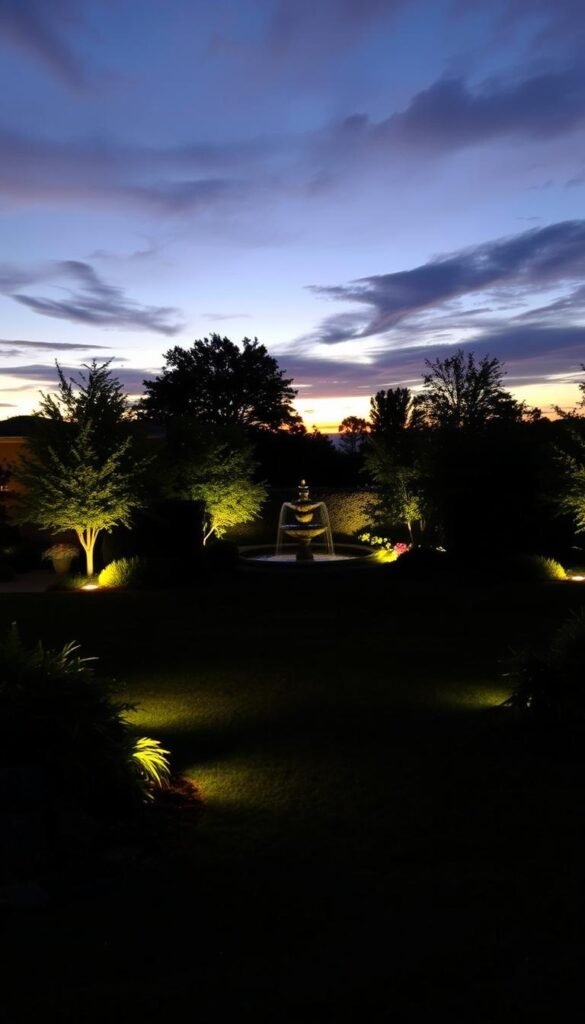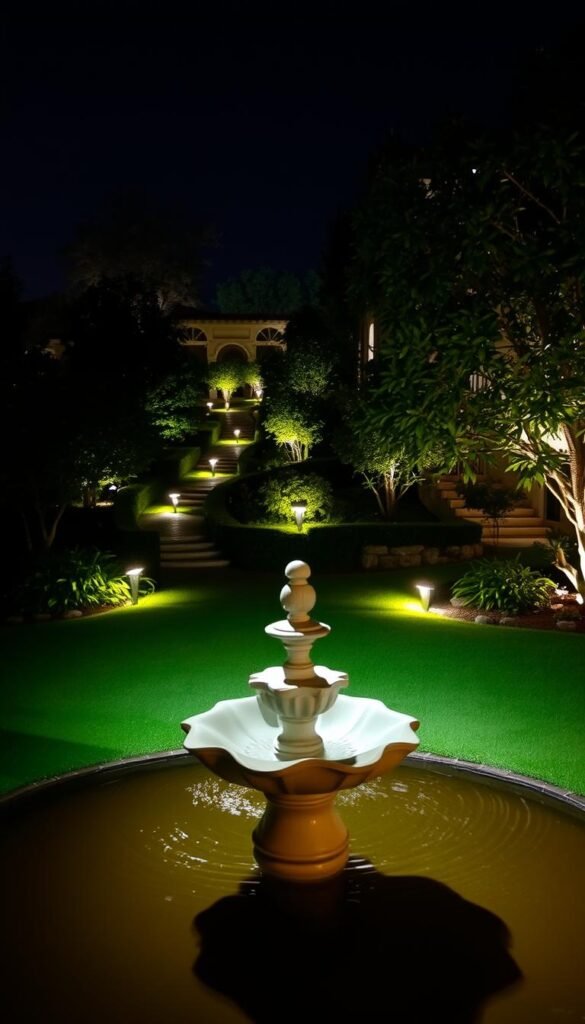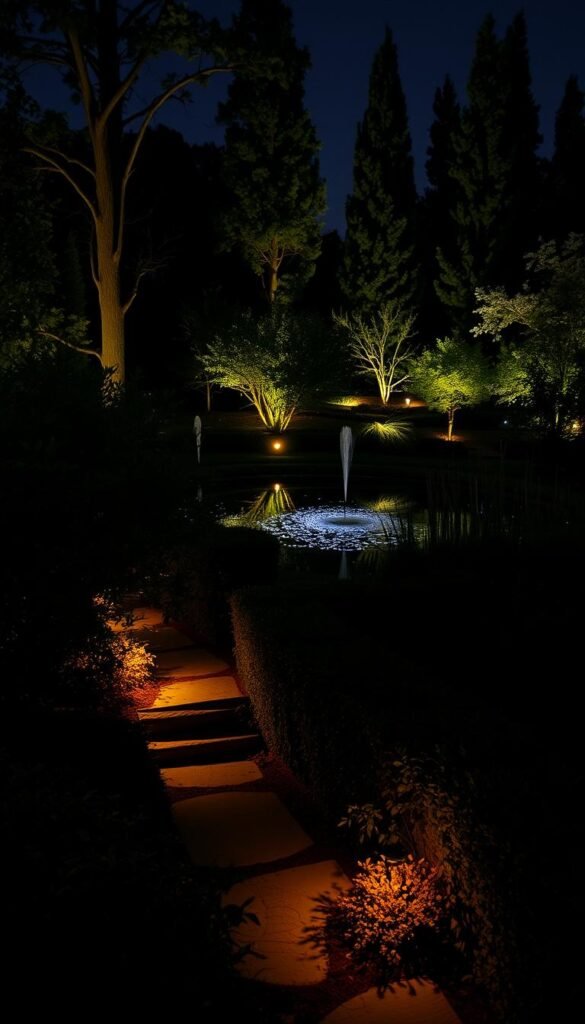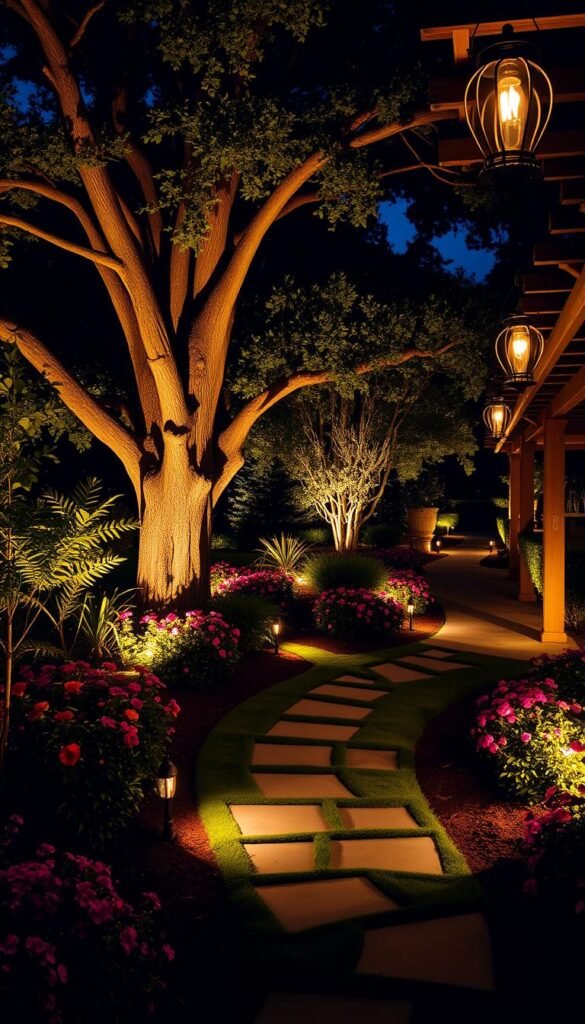Your home’s exterior deserves to shine after sunset just as brightly as it does during the day. With careful planning, you can turn ordinary areas into inviting retreats that blend beauty and practicality. Strategic outdoor illumination does more than brighten pathways—it transforms how you experience your property once the sun dips below the horizon.
Modern approaches go beyond basic fixtures. Professionals focus on balancing brightness levels to highlight architectural details while maintaining a welcoming atmosphere. This method turns trees, walkways, and seating areas into nighttime focal points, as detailed in this guide to essential illumination techniques.
Safety meets style when you layer different light sources. Subtle uplighting adds drama to stone walls, while recessed fixtures keep steps visible. Energy-efficient options now let you enjoy extended evenings outdoors without worrying about utility costs.
For those seeking enchantment, consider a harmonious blend of water features and soft. These elements work together to create soothing sounds and gentle glows that make every evening feel special.
Thoughtful arrangements extend your living area beyond four walls. Whether hosting friends or enjoying quiet moments, the right setup turns your property into a versatile space that delights long after twilight fades.
Understanding Outdoor Lighting and Its Impact on Your Garden

Transform your evenings by reimagining how you interact with nature after dark. Strategic placement of lights does more than chase away shadows—it reshapes how you experience your property’s unique character once stars appear.
How Lighting Extends Your Outdoor Living Space
Well-planned landscape lighting turns patios into midnight lounges and pathways into moonlit trails. Layer ambient glow with focused beams to create distinct zones for dining or quiet reflection. This approach lets you host summer barbecues or winter bonfires with equal ease, elevating your space into a true extension of your home.
Enhancing Safety and Visual Appeal with Thoughtful Illumination
Subtle path markers prevent stumbles while showcasing stonework textures. Uplighted trees become living sculptures, and recessed fixtures near steps eliminate tripping hazards. These elements work together to protect your family while making your property feel inviting after sunset.
Modern systems balance practicality with artistry. Soft washes of light reveal flowerbed colors that vanish at dusk, while motion-activated spots keep entryways secure. The result? A cohesive environment where safety and beauty share the spotlight.
Planning Your Garden Lighting Strategy

Crafting an effective lighting plan transforms how you experience your property after dark. Start by sketching a detailed map that marks your home’s architecture, walkways, and standout natural elements. This visual guide helps pinpoint where illumination will make the biggest impact while maintaining harmony with your surroundings.
Mapping Out Your Property and Key Focal Points
Walk your grounds at dusk to identify shadowy zones and eye-catching features. Mature trees become dramatic silhouettes with well-placed uplights, while stone walls gain texture through grazing techniques. Mark Piantedosi of Commonwealth Landscape Lighting suggests: “Space fixtures 20 feet apart to create gentle light transitions rather than harsh spotlights.”
Balancing Beauty and Functionality
Divide your space into zones based on activities. Cozy seating nooks thrive with warm 2700K LEDs, while grill stations need brighter 3000K beams. Motion-activated lights near entryways offer security without constant glare. Layer three types of illumination:
- Ambient: Soft overall glow from lanterns
- Task: Focused beams for cooking/reading
- Accent: Directional spots highlighting textures
Smart controls let you adjust brightness for different occasions—dimmed for stargazing, brighter for weekend gatherings. This approach ensures your setup works as hard during midnight snack runs as it does during dinner parties.
Garden Lighting Design: Illuminating Your Landscape for Nighttime Enjoyment

Transform your outdoor areas into inviting retreats by pairing innovative technology with creative placement. The secret lies in selecting components that work smarter, not harder, to create magical evenings.
Incorporating the Right Fixtures and Bulb Options
Match your fixtures to their purpose. Slim well lights disappear into flower beds, while adjustable spotlights make trees glow. For pathways, choose shielded lights that guide feet without blinding eyes.
LEDs revolutionize outdoor setups. These bulbs sip energy while shining bright—lasting 20 times longer than old halogens. Pick warm 2700K tones to mimic firelight’s cozy charm or cooler options for modern edges.
Using Low-Voltage Systems for Energy Efficiency and Safety
Modern 12-volt systems protect families and wallets. They use transformers to reduce household current, allowing flexible layouts without shocking risks. Professionals recommend sizing transformers 25% larger than needed for future additions.
This approach cuts energy use by 80% compared to traditional setups. You’ll enjoy glowing walkways and illuminated trees without tripping breakers or safety concerns. Smart controls add convenience—dim zones or set schedules from your phone.
Selecting Fixtures and Materials to Complement Your Landscape
The right fixtures turn functional spaces into nighttime showcases. Focus on matching hardware to your property’s needs while considering durability and visual harmony.
Choosing Path, Spot, and Well Lights for Different Areas
Bollard lights stand 18-24 inches tall, perfect for lining walkways or framing flower beds. Their low profile keeps attention on your greenery while guiding footsteps. For vertical surfaces like stone walls or wooden fences, wash lights cast smooth, even beams that emphasize texture without glare.
Need precision? Compact bullet-style spotlights let you highlight architectural details or tree canopies. Pair them with well lights sunk into soil for uplighting effects that make shrubs pop. These materials withstand rain, snow, and UV exposure—critical for long-term performance.
Balance style and practicality by mixing fixture types. Lightweight options work well for temporary setups, while heavier weather-resistant materials suit permanent installations. Your choices shape how guests experience every corner of your space after dark.






